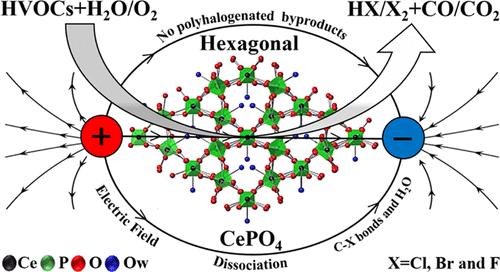当前位置:
X-MOL 学术
›
Environ. Sci. Technol.
›
论文详情
Our official English website, www.x-mol.net, welcomes your
feedback! (Note: you will need to create a separate account there.)
Catalytic Hydrolysis–Oxidation of Halogenated Methanes over Phase- and Defect-Engineered CePO4: Halogenated Byproduct-Free and Stable Elimination
Environmental Science & Technology ( IF 10.8 ) Pub Date : 2024-07-22 , DOI: 10.1021/acs.est.4c04436 Qiguang Dai 1 , Ronghua Xu 1 , Hangqi Xia 2 , Boyuan Qiao 2 , Qiang Niu 2 , Li Wang 1 , Aiyong Wang 1 , Yun Guo 1 , Yanglong Guo 1 , Wei Wang 3 , Wangcheng Zhan 1
Environmental Science & Technology ( IF 10.8 ) Pub Date : 2024-07-22 , DOI: 10.1021/acs.est.4c04436 Qiguang Dai 1 , Ronghua Xu 1 , Hangqi Xia 2 , Boyuan Qiao 2 , Qiang Niu 2 , Li Wang 1 , Aiyong Wang 1 , Yun Guo 1 , Yanglong Guo 1 , Wei Wang 3 , Wangcheng Zhan 1
Affiliation

|
Catalytic elimination of halogenated volatile organic compound (HVOC) emissions was still a huge challenge through conventional catalytic combustion technology, such as the formation of halogenated byproducts and the destruction of the catalyst structure; hence, more efficient catalysts or a new route was eagerly desired. In this work, crystal phase- and defect-engineered CePO4 was rationally designed and presented abundant acid sites, moderate redox ability, and superior thermal/chemical stability; the halogenated byproduct-free and stable elimination of HVOCs was achieved especially in the presence of H2O. Hexagonal and defective CePO4 with more structural H2O and Brønsted/Lewis acid sites was more reactive and durable compared with monoclinic CePO4. Based on the phase and defect engineering of CePO4, in situ diffuse reflectance infrared Fourier transform spectra (DRIFTS), and kinetic isotope effect experiments, a hydrolysis–oxidation pathway characterized by the direct involvement of H2O was proposed. Initiatively, an external electric field (5 mA) significantly accelerated the elimination of HVOCs and even 90% conversion of dichloromethane could be obtained at 170 °C over hexagonal CePO4. The structure–performance-dependent relationships of the engineered CePO4 contributed to the rational design of efficient catalysts for HVOC elimination, and this pioneering work on external electric field-assisted catalytic hydrolysis–oxidation established an innovative HVOC elimination route.
中文翻译:

相和缺陷设计的 CePO4 上卤化甲烷的催化水解-氧化:无卤化副产物且稳定消除
通过传统的催化燃烧技术催化消除卤化挥发性有机化合物(HVOC)排放仍然是一个巨大的挑战,例如卤化副产物的形成和催化剂结构的破坏;因此,迫切需要更有效的催化剂或新的路线。在这项工作中,晶相和缺陷设计的CePO 4被合理设计,并呈现出丰富的酸位、适度的氧化还原能力和优异的热/化学稳定性。特别是在 H 2 O 存在的情况下,实现了无卤化副产物且稳定消除 HVOC。与单斜 CePO 4相比,具有更多结构 H 2 O 和布朗斯台德/路易斯酸位点的六方缺陷 CePO 4更具反应性和耐用性。基于CePO 4的相和缺陷工程、原位漫反射红外傅里叶变换光谱(DRIFTS)和动力学同位素效应实验,提出了一条以H 2 O直接参与为特征的水解-氧化途径。首先,外部电场(5 mA)显着加速了 HVOCs 的消除,甚至在 170 °C 的六方 CePO 4上可以实现 90% 的二氯甲烷转化。工程CePO 4的结构-性能依赖关系有助于合理设计用于HVOC消除的高效催化剂,而这项关于外部电场辅助催化水解-氧化的开创性工作建立了一条创新的HVOC消除路线。
更新日期:2024-07-22
中文翻译:

相和缺陷设计的 CePO4 上卤化甲烷的催化水解-氧化:无卤化副产物且稳定消除
通过传统的催化燃烧技术催化消除卤化挥发性有机化合物(HVOC)排放仍然是一个巨大的挑战,例如卤化副产物的形成和催化剂结构的破坏;因此,迫切需要更有效的催化剂或新的路线。在这项工作中,晶相和缺陷设计的CePO 4被合理设计,并呈现出丰富的酸位、适度的氧化还原能力和优异的热/化学稳定性。特别是在 H 2 O 存在的情况下,实现了无卤化副产物且稳定消除 HVOC。与单斜 CePO 4相比,具有更多结构 H 2 O 和布朗斯台德/路易斯酸位点的六方缺陷 CePO 4更具反应性和耐用性。基于CePO 4的相和缺陷工程、原位漫反射红外傅里叶变换光谱(DRIFTS)和动力学同位素效应实验,提出了一条以H 2 O直接参与为特征的水解-氧化途径。首先,外部电场(5 mA)显着加速了 HVOCs 的消除,甚至在 170 °C 的六方 CePO 4上可以实现 90% 的二氯甲烷转化。工程CePO 4的结构-性能依赖关系有助于合理设计用于HVOC消除的高效催化剂,而这项关于外部电场辅助催化水解-氧化的开创性工作建立了一条创新的HVOC消除路线。











































 京公网安备 11010802027423号
京公网安备 11010802027423号